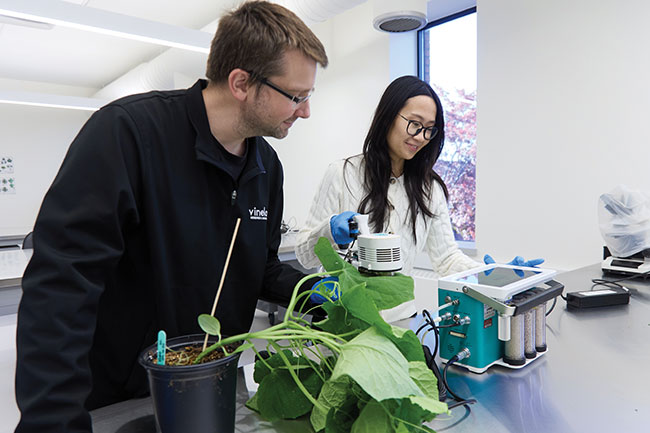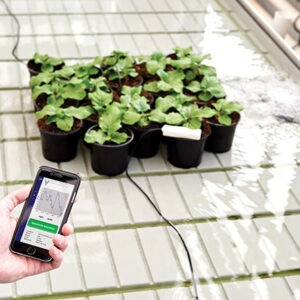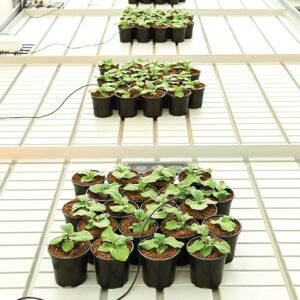
Features
Water wisdom
Comparing sustainable greenhouse irrigation solutions
March 18, 2024 By J Lynn Fraser
 Jason Henry, MSc, Research Scientist, Soils, Plant Responses & the Environment and Qinglu Ying, PhD, Research Scientist, Plant Production at Vineland Research and Innovation Centre.
Photo by Vineland Research and Innovation Centre.
Jason Henry, MSc, Research Scientist, Soils, Plant Responses & the Environment and Qinglu Ying, PhD, Research Scientist, Plant Production at Vineland Research and Innovation Centre.
Photo by Vineland Research and Innovation Centre. Agriculture, globally, is one of the largest users of clean water. Climate change and increasing worldwide water use is also decreasing sources of clean water. Since water use in agriculture is costly, being innovative finding sustainable water sources is good business.
Plants grown in greenhouses need clean, consistent, managed water sources to be healthy. This entails water delivery and moisture levels that are appropriate for plants, leaves, and root systems.7 Sustainable irrigation keeps costs low and ensures that plants are efficiently fertilised.1
“The rule of thumb” for greenhouse water usage is a minimum of 0.2 gallons/sq. ft of growing area. On warm days that amount may change to 0.3 to 0.4 gallons/sq. ft of growing area. For 10,000 sq. ft that is 3,000 to 4,000 gallons/day, notes Jason Henry MSc, Research Scientist, Vineland Research and Innovation Centre.
Sustainable water sources
Sustainable water can be found in stored rain water, sourced from roof eavestroughs and kept in storage tanks, and ponds. Water from these sources needs to be filtered. It also needs aeration to help “prevent algae blooms, anaerobic pathogens, anoxic release of nutrients.” Water fountains, air compression systems, drum filters, as well as sand and gravity, can help clean the water.5
“Rainwater harvesting,” says Henry, “is a good source of water depending on how you collect it. Take the water from gutters and direct it into a cistern.”
The method of collection, however, has an effect, he cautions. “Debris and potential contaminants need filtering.” A negative aspect of rain water, Henry points out, “is that you have to rely on when it rains. A concern in times of drought. Storage is important because it is depleted quickly.”
Groundwater is also a sustainable water source. “Obtained from wells, groundwater is a common, relatively clean source of water,” says Balsher S. Sidhu, PhD, Adjunct Professor, Institute for Resources, Environment and Sustainability, UBC. “Water supplied by city, county, or municipality is also typically of high quality but may involve higher costs, especially for smaller greenhouse operations,” Sidhu notes.
New water sources are being studied. For example, Jurga et al. studied the collection and use of outdoor and indoor condensate recovery systems like air conditioning systems in greenhouses. This water can be used with liquid fertilizers, and in closed systems such vertical farming and aquaponic farms.6 Kajale (2013) found that one air handling unit in an American university building produced 55.27 million litres of condensate over 17 months. Drain pans can collect condensate that is then piped to storage areas. Water can also be sourced from irrigation and washdown leachate recapture.2 In ebb and flow systems a collection tank underneath re-uses water and the water is sent to a collection system, Henry comments. Other sources include “desalination,” “solar distillation, cloud seeding, atmospheric water vapour harvesting, and water recovery from wastewater streams,” and “potential of the water recovery from the air.” 6
Clean water = Healthy plants
Plants exposed to water containing contaminants will have “slow growth, poor aesthetic quality,” and will slowly die. Additionally, “high soluble salts can hurt root systems, can affect “water and nutrient uptake,” and can “accumulate in plant leaf margins, causing burning of the edges.” When there is “high alkalinity” the growing media’s pH is affected and this affects nutrient uptake.” 8
Sustainable irrigation
Fertigation is the mixing of fertilizer into the water supplied by drip irrigation. One of the advantages of this approach is that “Growers can fertilize with more precision than manual methods.” It can result in increased crop yield of more than 60 per cent according to one study. 1
Re-cycling water is advantageous as it decreases costs of water input. The disadvantage, Henry notes, is that as plants are up taking the water the leachate is high in nutrients, like nitrogen, phosphates, and potassium. Growers tend to have “a water sampling program. They test the water for pathogens before use.” The “rule of thumb for growers is that 20 per cent of the water they apply becomes leachate,” Henry said.
To innovate or not to innovate
Growers “may raise objections due to concerns about technological limitations of available systems; the potential increase in energy requirements if they are required to transition to a high-efficiency irrigation system; the significant initial investment and ongoing operational costs; and the reliability and availability of water resources. Behavioral barriers, such as resistance to change and lack of awareness, and regulatory constraints act as obstacles to widespread adoption of sustainable irrigation practices in commercial agriculture,” Sidhu observes.
Irrigation systems — How good is the fit?
“You need the right media for the right crop,” Henry says. “Different types of growing media, like coir, peat, bark-based substrates make water available at different levels, so you have to know your growing media before you change your irrigation system.” Growers need to know when water is available. Some of the factors involved in choosing any irrigation system includes cost, additional labour that is involved in testing, and needed adjustments. “This can be challenging especially during the growing season.”
If you will be using soluble fertilizers in the irrigation water it is important to “allow at least 10–15 per cent for leaching to avoid salt build up.” 10 Adequate absorption, porosity and water holding capacity of the growing media” should be factored into irrigation choices. “Substrate selection varies depending on the crop” and “substrate properties depend on how you water it,” says Henry.
Ozone
The advantage of this system is that it can “effectively sterilize and is cleaner, pathogens and diseases eliminated, and it could supply dissolved oxygen in the irrigation system,” Henry points out. Other advantages of ozone is that it will “destroy contaminants completely”; “breakdown pathogens by oxidation”; is more effective than UV light. Additionally, due to the dissolved oxygen in the water there is strong plant growth, a “reduced risk of disease,” and the closed loop system reduces water costs.3
Another advantage of the ozone system is its flexibility. It can be installed to disinfect as a batch process or on demand. The system does need filters to be installed as they remove particulate matter that escapes from the solution. As ozone is produced as part of the process, it does not need chemicals to be stored on site. The system has low electricity demands and thus low operating costs.5
An important disadvantage of ozone, says Henry, is that it is toxic. “There are safety concerns. It can also be costly to set up.”
UV light
This irrigation process “can sterilize pathogens and diseases in greenhouse water,” Henry notes, and “needs a cleaning system before you re-use the water.” The advantage of using this process is that it “disinfects the water and sterilizes the contaminants” when the water is in the UV chamber. 3 UV light does have safety concerns and costs that need to be considered, Henry observes.
Facility controller to manage water use
Advantages of this irrigation process is that it can be programmed into considering the environment the plants are growing in. A “greenhouse system,” Henry notes, “has light, temperature, humidity, and growing media to consider.” To deal with the numerous decisions that have to be made concerning those elements a “cost effective strategy” is a computer system and “set protocols for water use and efficiency and pre-set decisions.”
This irrigation process has, according to Henry, “a big learning curve depending on how many crops, which equals the numbers of irrigation pipes. It needs a lot of planning.”
Drip Irrigation
“Efficient and useful, drip irrigation helps growers of all experience levels control the amount of water delivered to plants.” 1 The type of crops grown with this system are, “typically cucumbers and tomatoes grown in rockwool,” says Henry. The advantage of this system is that it is “cost effective, there is decreased leachate water, and the nutrients are directed right onto the root systems,” Henry adds. The drip and trickle approach is viewed by some as being more efficient and easier to control.10 Drip irrigation is seen as increasing production from “20 to 90 per cent” while sending “water and nutrients directly to the roots it saves 50 to 70 per cent more water” than a typical system would.4
The disadvantage with this system is that there can be “salt build-up, nutrients can clog up, and it will need a lot of cleaning so it can become less efficient.” Henry also cautions that the water used in this process can be reused, but it may have pathogens.
Overhead sprinklers
These are a “low-cost system that sprays water out increasing the relative humidity,” Henry comments. They are “good for grapes.” The disadvantage is that the system works best with crops that are not “sensitive to leaf borne disease.”
This irrigation type is associated, by some, with water wastage and wetting foliage, which leads to disease.10
Hydroponics and aquaponics
An advantage of hydroponics is that water is stored in cisterns and “plants only use what they need.” 1 Fewer resources are used and arable land isn’t necessary.11 Both water and space, especially when the plants are growing vertically, are saved in this method.” These systems “tend to be automated,” which makes “operating and growing them easier.” 1 A study of lettuce, showed that the yield from a hydroponic system was “12 times more yield per litre of water.” 1
In both hydroponics and aquaponics, the systems are not bound by seasons, with few environmental impacts except for the disposal of chemicals and fertilizers in hydroponics. In both systems the plants have been found to be healthier with yields 30 to 40 per cent higher than traditional systems.11
The hydroponic and aquaponics systems tend to be of better quality, notes Lisa Y. Stein Professor and Associate Dean (Mentorship and Awards), Climate Change Microbiology at the University of Alberta. “Most commercial aquaponics facilities focus on leafy greens as they have a fast growth rate and turn-around time and do not have complicated flowering cycles,” says Stein. Compared to other systems, aquaponics are viewed as being more sustainable. “There are fewer inputs for aquaponics as the fish provide the fertilizer,” Stein notes.
Aquaponics’ start-up time is related to an operation’s size. “It depends on the scale and where the microbial inoculum comes from. In our mini-systems, we developed the microorganisms before hand and inoculated with a mature biofilm. Our system was stable within
two weeks.”
In the literature, aquaponics is viewed as more sustainable compared to hydroponics. “The fish and microbes provide essential nitrogen, other nutrients, and plant growth promoting molecules to the crop. Aquaponics provides a nearly closed loop of inputs to waste management,” said Stein.
Innovation and sustainability are the future of commercial greenhouses. “Sustainable irrigation methods, when integrated with precise fertilization techniques, can improve fertilizer efficiency, minimize weed growth, and reduce the spread of diseases caused by excess moisture,” Sidhu says.
Sources
- Americover, 2024, ‘Sustainable irrigation techniques growers should consider.’ https://www.americover.com/sustainable-irrigation-techniques-growers-should-consider/
- Ceres Greenhouse Solutions, 2023, ‘Water circularity: Considerations for your greenhouse water systems,’ https://ceresgs.com/water-circularity-considerations-for-your-greenhouse-water-systems/
- Climate Control Systems, 2023, ‘Understanding greenhouse water treatment.’ https://www.climatecontrol.com/blog/greenhouse-water-treatment-ozone-uv/#:~:text=Reduced%20waste%3A%20Ozone%20Purification%20reduces,a%20lot%20of%20water%20costs.
- GGS Structures inc., 2022, ‘How you can conserve water in your greenhouse facilities.’ https://ggs-greenhouse.com/blog/how-you-can-conserve-water-in-your-facilities
- Humphrey, T., 2011, Greenhouse Product News, ‘Sustainable solutions to greenhouse irrigation management,’ https://gpnmag.com/article/sustainable-solutions-greenhouse-irrigation-management-0/
- Jurga, A., Pacak, A., Pandelidis, D., Kaźmierczak, B., 2023, ‘Condensate as a water source in terrestrial and extra-terrestrial conditions,’ Water Resources and Industry, Vol 29, 100196, https://doi.org/10.1016/j.wri.2022.100196
- Nichepom, 2024, ‘Niche agriculture, Water management in greenhouse irrigation,’ https://www.nicheagriculture.com/water-management-in-greenhouse-irrigation/
- Saskatchewan.ca, ‘Water quality in greenhouses’ https://www.saskatchewan.ca/business/agriculture-natural-resources-and-industry/agribusiness-farmers-and-ranchers/crops-and-irrigation/horticultural-crops/greenhouses/water-quality-in-greenhouses
- Gramling, C., 2024, ‘Many but not all of the world’s aquifers are losing water,’ Science News, https//www.sciencenews.org/article/aquifers-losing-water-climate-overuse
- Texas A&M Agricultural Extension, ‘Ornamental Production – Irrigating greenhouse crops,’ https://aggie-horticulture.tamu.edu/ornamental/greenhouse-management/irrigating-greenhouse-crops/
- Trees.com Staff, 2022, ‘Hydroponics vs. aquaponics – A complete, and honest comparison,’ https://www.trees.com/gardening-and-landscaping/hydroponics-vs-aquaponics#:~:text=Hydroponics%20growing%20systems%20can%20be,other%20leafy%20greens%2C%20and%20herbs.
Print this page

